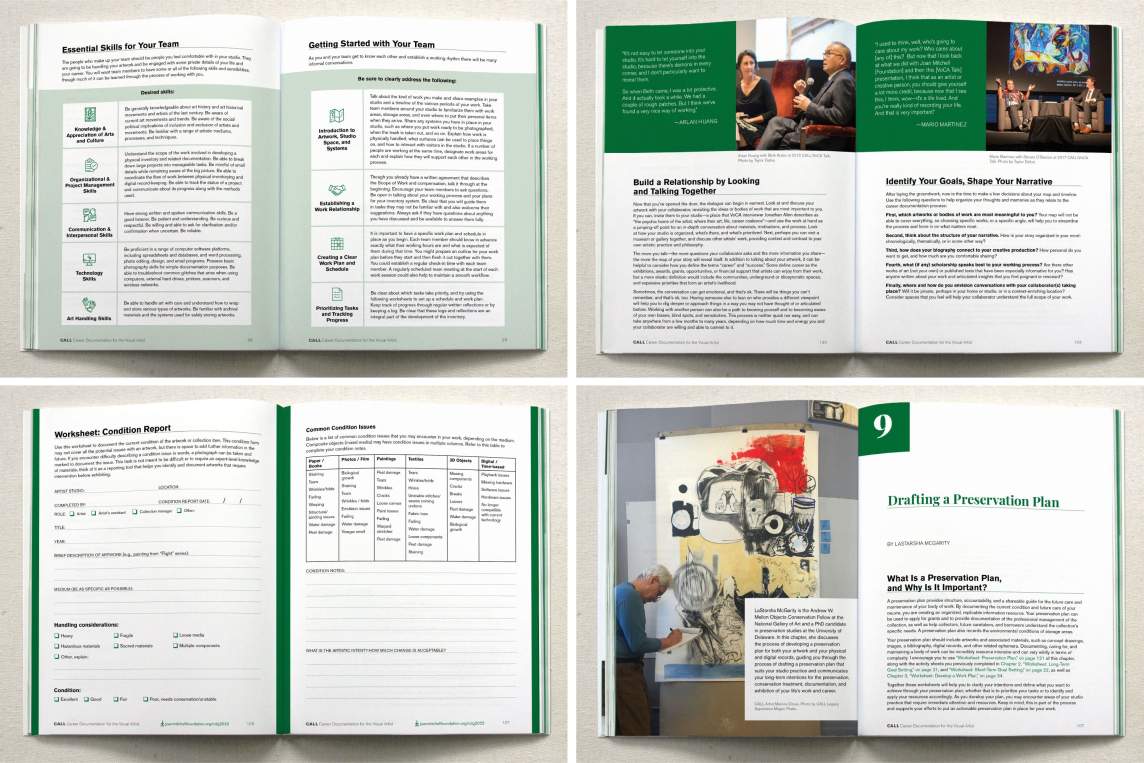Looking Back at 2025: Celebrating Joan Mitchell and Her Impact
As we close out 2025 and Joan Mitchell’s Centennial celebration, we’re reflectin...

We are thrilled to announce the publication of Career Documentation for the Visual Artist: A Legacy Planning Workbook & Resource Guide. Developed in collaboration with artists, arts professionals, and legal and financial experts over the course of two years, the workbook provides a breadth of information and perspectives about legacy planning for artists, along with practical tools that support engagement with this long-term, and sometimes challenging, process. The new text is part of the Foundation’s ongoing Creating a Living Legacy (CALL) initiative, which for 15 years has supported artists in their efforts to catalogue, manage, and preserve their life’s work. Career Documentation for the Visual Artist is available as a free PDF download, e-book, and audiobook, with a print-on-demand workbook offered at cost ($13) via Lulu Bookstore.
“Through our work as stewards of Joan Mitchell's legacy, we at the Foundation recognize both the complexity of this work and how important it is for artists to play an active role in preserving and shaping their legacies during their lives,” said Christa Blatchford, the Joan Mitchell Foundation’s Executive Director. “With the CALL initiative, we have been advancing the dialogue around artists’ legacies, with an emphasis on empowering artistic communities that have been historically underrepresented and whose creative work deserves greater recognition and ongoing preservation. We look forward to offering the new Career Documentation for the Visual Artist workbook as another resource through which we can connect with artists about this essential process.”

Career Documentation for the Visual Artist (2022) follows the previously published Career Documentation Guide, which was released in 2012. The new workbook is a complete rewrite of the original text and explores a broad range of topics, including long and short-term goal setting, financial planning, time management, artwork inventorying, the creation of digital assets, and preservation planning, among others. At the heart of the workbook is the understanding that the work of legacy planning cannot be done alone—that it is best achieved through a collaborative process among a team of individuals committed to a shared understanding of the specific vision, need, and aspirations of each artist. The workbook acknowledges that legacy planning can feel daunting and provides encouragement, advice, and clear and accessible guides for both beginning and continuing the work.
The new guide is further distinguished by its embrace of a wide spectrum of voices and experiences. Career Documentation for the Visual Artist includes a selection of first-person essays, including an introduction by Los Angeles-based artist and educator Paul Mpagi Sepuya, and case studies of work done by such individuals and collectives as artist Aminah Brenda Lynn Robinson (1940–2015) and Bay Area Women Artists’ Legacy Project (BAWALP). The text recognizes advances in technology—including the ways in which it has both eased and complicated content management—and responds to feedback from artists and professionals about the accessibility and scope of the workbook contents. Career Documentation for the Visual Artist is also a companion to the Foundation’s two estate planning guides, which instruct individual artists and their attorneys or estate executors on legal matters pertaining to intellectual property, copyright, and various estate vehicles. Together, these publications provide critical resources for artists at all career stages.
'Career Documentation for the Visual Artist' is an uplifting read for all artists, put together with much thought and insight. This remarkable workbook is a treatise on why our voices are important as individuals, especially for those of us who have been left out of the dominant art historical record. It is imperative that we archive our own work, as Tempestt Hazel says, as 'evidence of the communities I belong to.' If those communities are to grow, they must have records, archives, and shoulders to stand on.”
Arlan Huang, Artist supported through the CALL Initiative, 2013
“The notion of care has been a central aspect in the development of the workbook and in what it conveys to those who might use it. It was essential to everyone involved that the text recognize the multiplicity of experiences of artists at different stages in their careers and that it provides the support necessary to inspire and invite people into this process,” said Shervone Neckles-Ortiz, Joan Mitchell Foundation’s Artist Programs Manager, Professional Development, and co-editor of the workbook. “For this reason, the workbook dedicates considerable space to the importance of establishing a support system and team, and it reflects an incredible range of voices and perspectives, whether through direct writings or through the review and feedback that led to its completion.”
Career Documentation for the Visual Artist is co-edited by Shervone Neckles-Ortiz and Kay Takeda, who previously served as Deputy Director, Artist Programs at the Joan Mitchell Foundation. It includes contributions from artists and educators Rose Candela, Catherine Czacki, Jennifer Patiño, Antonia A. Perez, Paul Mpagi Sepuya, and Jan Wurm; arts and professional administrators Virginia Allison-Reinhardt, Steven G. Fullwood, Jim Grace, Margaret Graham, Tempestt Hazel, LaStarsha McGarity, and Sharon Mizota; and legal and financial experts Luke Blackadar, Elaine Grogan Luttrull, and Deidre Hamlar. The workbook was designed by Melissa Dean. The editors are grateful for the internal and external reviewers whose feedback helped shape the final version of this guide, including Andrew Beccone, Joey Cabrera, Pamela Council, Krista Fabian DeCastro, Jenny Gill, Arlan Huang, Laura Morris, Alexandra Tagami Vargo, and Suzi Villiger.
I can’t emphasize enough how invaluable the content in the Joan Mitchell Foundation's new Career Documentation workbook is! It is comprehensive, high quality, and highly relevant. Covering everything from digital asset management to career mapping, with artists' case studies in between, this guide will make a huge impact.”
Pamela Council, 2017 Painters & Sculptors Grant Recipient